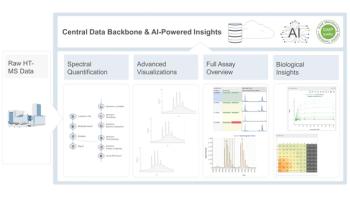
- July 2024
- Volume 20
- Issue 7
- Pages: 25–30
A Study on the Optimization of the Ion-Pair Reversed Phase Liquid Chromatography Analysis of Protected And Unprotected DNA Oligonucleotides
This article describes a comprehensive study on optimizing ion-pair reversed-phase liquid chromatography for analysing protected and unprotected single-stranded DNA oligonucleotides.
This article describes a comprehensive study on optimizing ion-pair reversed-phase liquid chromatography for analysing protected and unprotected single-stranded DNA oligonucleotides. The study identifies optimal conditions for improved chromatographic resolution and discusses the advantages of using bioinert column hardware and specific temperature settings to enhance the recovery and peak shapes of oligonucleotides, providing a detailed guide for similar analytical setups in the field.
Oligonucleotides have become more and more important in terms of things like polymerase chain reaction and successful treatment of diseases such as viral infections or cancer (1,2). Because of oligonucleotides’ very polar properties and electron-rich backbone, high-performance liquid chromatography (HPLC) has become the standard separation technique. Typically, ion-pair reversed-phase high performance liquid chromatography (IP-RP-HPLC) or anion-exchange (AEX) chromatography are used, but hydrophilic interaction chromatography (HILIC) and size-exclusion chromatography (SEC) have also been applied to an increasing extent (3–5). However, the electron-rich phosphate backbone of DNA causes retention on common hydrophobic stationary phases to be low. Ion-pairing agents such as n-alkylamines can help to overcome this challenge. The ion pairs formed between N-alkylamines and oligonucleotides can be separated according to their hydrophobicity using a reversed-phase column.
Short oligonucleotides are usually produced using solid-phase synthesis (6). To achieve a controlled sequence, the 5' terminus protected with a protecting group such as dimethoxytrityl (DMT). After successful synthesis, respectively after every synthesis step, the protecting group is removed.
In this article, the optimization of the analysis of two single-stranded DNA samples (20mer) using IP-RP-HPLC is described. Both samples consist of the same sequence but differ in the presence (Trityl-ON) or absence (Trityl-OFF) of the DMT protecting group. Parameters such as ion-pairing agents and their concentration, gradient, column hardware and temperature were optimized for both samples.
Experimental
Two single-stranded DNAs (20mer), one with the DMT protecting group on (Trityl-ON) and one with the protecting group already removed (Trityl-OFF), with the following sequence:
5’-ATACCGATTAAGCGAAGTTT-3
were used in this study. The general conditions were kept as follows: flow rate 0.2 mL/min, UV detection at 260 nm, injection of 5 μL. The screening gradient was 15–35 %B in 30 min with mobile phase B being acetonitrile and using dibutyl ammonium acetate (DBAA), triethyl ammonium acetate (TEAA) or triethylamine (TEA) with 1,1,1,3,3,3-hexafluoride-2-propanol (HFIP) as mobile phase A at concentrations of 10 mM and 100 mM for HFIP (pH not adjusted). During optimization, different concentrations of the ion-pairing agents were used. In selected cases, methanol instead of acetonitrile was applied as mobile phase B. The optimised gradient slope is 0.42 %B/min–0.58 %B/min depending on the ion-pairing agent used. Two different ultrahigh-pressure (UHPLC) column hardware options packed with an organic/inorganic hybrid-silica C18 phase (12 nm, 1.9 μm) were tested: stainless steel (100 × 2.0 mm i.d, 1.9 μm YMC-Triart C18) and abioinert coated stainless steel (100 × 2.1 mm i.d, YMC Accura Triart C18). The column temperature was kept at 25 °C for screening of the ion-pairing agents and column hardware options. A temperature screening was performed using temperatures between 15–90 °C, therefore the flow rate was increased to 0.4 mL/min in order to shorten the run time.
Influence of the Type and Concentration of Ion-Pairing Agent
DBAA, TEAA and TEA with HFIP were used for the initial screening at concentrations of 10 mM and 100 mM for HFIP (pH not adjusted). Acetonitrile was chosen as eluent B and a gradient from 15–35 %B in 30 min was applied (not shown, [7]). When using TEAA, the retention time of the sample is very short. In addition, multiple peaks are eluted, indicating the ion-pairing is incomplete. The chromatogram of the Trityl-ON sample shows that there is no elution when using DBAA. A peak is obtained for Trityl-OFF but its resolution and peak shape are not sufficient. When using TEA-HFIP, both samples are eluted directly from the column, indicating that the initial conditions are too strong.
The gradient and starting conditions are adjusted in the next step. For TEAA, the gradient slope was reduced to 0.5 %B/min so that a gradient of 15–45 %B in 60 min is obtained. The starting conditions for DBAA were set to 20 %B and the acetonitrile ratio was increased with the initial gradient slope (0.67 %B/min) to 40 %B in 30 min. Regarding TEA-HFIP, two distinct gradients were applied for the DNA samples. A reduction in the initial gradient ratio was necessary to attain retention. For Trityl-ON, a gradient of 0–35 %B in 60 min (0.58 %B/min) was applied, while for Trityl-OFF, a shallower gradient of 0–25 %B (0.42 %B/min) was used. The organic solvent was changed from acetonitrile (ACN) to methanol (MeOH) using TEA-HFIP as eluent A, as HFIP is not soluble in acetonitrile. Methanol was also used for the separation using TEAA as ion-pairing agent. TEA-HFIP provides the highest resolution and best separation for both samples. The chromatograms with optimized conditions can be seen in Figure 1.
The optimum concentration of the ion-pairing agent depends largely on the sample. Therefore, both lower and higher concentrations were tested (Figure 2). The exception was TEAA, which was only tested at a higher concentration of 100 mM because the sample was not fully paired at a concentration of 10 mM. In addition, different TEA concentrations were tested in combination with 100 mM as well as 200 mM HFIP.
Using 100 mM TEAA instead of 10 mM increased the retention time for both samples. The peak for unpaired DNA is reduced, showing complete pairing had not been achieved.
With the lowest DBAA concentration of 5 mM, the samples are not fully paired. The main peak broadens. At the highest concentration of 25 mM DBAA, the retention time increases but the peaks become broader, too (not shown). TEA concentrations of 5 mM, 10 mM and 15 mM were tested in combination with 100 mM and 200 mM HFIP, respectively. Increasing the TEA concentration led to a significant increase in separation efficiency. Doubling the HFIP concentration had only a slight effect when using a concentration of 5 mM TEA or 10 mM TEA. One reason could be that the thermodynamic equilibrium for the protonation of TEA has already been reached with 100 mM HFIP. At a concentration of 15 mM TEA, increasing the HFIP concentration improves resolution and separation efficiency more significantly.
The following concentrations provided the best resolution and peak shape and were therefore selected for further testing:
- 100 mM TEAA
- 10 mM DBAA
- 15 mM TEA + 200 mM HFIP
The Effect of Bioinert Column Hardware
Oligonucleotides can be irreversibly adsorbed on metal surfaces, including the wetted parts of conventional (U)HPLC columns. This nonspecific adsorption significantly disrupts recovery and peak shape. The effect is even greater when working at low to neutral pH, as metals are more electropositive under these conditions. To solve this problem, HPLC columns and systems can be passivated with strong acids or pre-conditioned with a similar sample (8). However, these procedures are time-consuming and a recurring task. In addition, nonspecific adsorption can occur again when the sample is charged.
A simpler and much more robust and reliable solution is to use fully bioinert columns. Different bioinert concepts are available: a bioinert coating of the stainless steel column body and frits, PEEK-lined stainless steel columns in combination with PEEK frits, and columns made of titanium. In this study, a column with a bioinert polymer coating of the column and frits was used. A direct comparison between regular stainless steel hardware and bioinert coated column hardware shows the clear advantages of the bioinert column: improved resolution and recovery (Figure 3).
The previously optimized ion-pairing agent concentrations and gradients were applied. For the further investigations, only the stainless steel column was used.
Optimum Column Temperature
Temperature can have a significant impacton the retention in IP-RP-HPLC because the electrostatic interactions with the ion-pairing agents are usually enhanced as the temperature is increased (9). Meanwhile, the hydrophobic adsorption strength of the oligonucleotides and ion-pairing agents on the stationary phase decreases. For this reason, the temperature optima are highly dependent on the ion-pairing agents, organic solvents and the samples themselves and require experimental determination of the temperature optimum. To determine the optimal temperatures, samples were analyzed at different temperatures between 15 °C (25 °C) and 90 °C. In order to shorten the run time for the different methods, the flow rate was previously doubled to 0.4 mL/min. In all cases, doubling the flow rate resulted in a lower separation efficiency than for the previous flow rate. The effect of temperature on the separation of Trityl-ON and Trityl-OFF DNA samples is shown in Figure 4.
With a temperature change, the separation efficiency for TEAA and DBAA was improved, which in turn exceeds the separation efficiency at a flow of 0.2 mL/min. The optimum temperature for both samples is 60 °C for TEAA and DBAA. For TEA-HFIP the separation efficiency and resolution decrease with increasing temperature. Therefore, lower temperatures of 15 °C and 20 °C were also investigated. At lower temperatures significant tailing is seen for both samples. Therefore, the optimum temperature for both samples was 25 °C.
Conclusions
In this study, several key parameters of the IP-RP analysis of oligonucleotides were examined. For the analysis of the single-stranded DNA samples in this study, Trityl-ON and Trityl-OFF, 15 mM TEA and 200 mm HFIP with two distinct gradients for both samples provided the best results at a lower temperature of 25 °C (Figure 4). Using TEA-HFIP as the ion-pairing agent entails the advantage of mass spectrometry (MS) compatibility. However, the high costs of HFIP and the environmental concerns regarding polyfluorinated substances are a disadvantage. A TEAA buffer is also MS-compatible and offers very good resolution as a cost-effective alternative, especially for high-throughput analyses. Additionally, for the separation of DNA samples both protected and unprotected, the ion-pairing agent TEAA provided the best resolution at a concentration of 100 mM with a gradient slope of 0.5 %B/min over 60 min (see Figure 5). In addition, bioinert column hardware is crucial for ideal and reliable results, ideally in combination with a bioinert (U)HPLC system. This boosts recoveries and ideal peak shapes are achieved. Nevertheless, the analysis of DNA using IP-RP-HPLC must always be individually optimized to the properties of the respective DNA.
Acknowledgments
We gratefully acknowledge Jessica Ulke (University of Münster) for the experimental contribution to this work during her internship at YMC Europe GmbH.
References
(1) Goyon, A.; Yehl, P.; Zhang, K. Characterization of Therapeutic Oligonucleotides by Liquid Chromatography. J. Pharm. Biomed. Anal. 2020, 182, 113105. DOI:
(2) Bateman-House, A.; Kearns, L. Individualized Therapeutics Development for Rare Diseases: The Current Ethical Landscape and Policy Responses. Nucleic Acid Ther. 2021, 32 (2), 111–117. DOI:
(3) Gilar, M.; Fountain, K. J.; Budman, Y.; et al. Ion-Pair Reversed-Phase High-Performance Liquid Chromatography Analysis of Oligonucleotides:: Retention Prediction. J. Chromatogr. A 2002, 958 (1–2), 167–182. DOI:
(4) Lardeux, H.; Goyon, A.; Zhang, K.; Nguyen, J. M.; Lauber, M. A.; Guillarme, D.; D’Atri, V. The Impact of Low Adsorption Surfaces for the Analysis of DNA and RNA Oligonucleotides. J. Chromatogr. A 2022, 1677, 463324. DOI:
(5) Arend, K. Separation of siRNA and Its Single Strands by SEC Using YMC-Pack Diol-120; YMC Application Note; YMC Europe GmbH: Dinslaken, Germany, 2023.
(6) Oligonucleotide Synthesis: Methods and Applications; Herdewijn, P., Ed.; Methods in Molecular Biology, Vol. 288; Humana Press, 2005.
(7) Rojahn, A. M. Optimising the IP-RP Analysis of Protected and Unprotected Oligonucleotides; YMC Technical Note; YMC Europe GmbH: Dinslaken, Germany, 2024.
(8) Gilar, M.; DeLano, M.; Gritti, F. Mitigation of Analyte Loss on Metal Surfaces in Liquid Chromatography. J. Chromatogr. A 2021, 1650, 462247. DOI:
(9) Kadlecová, Z.; Kalíková, K.; Tesařová, E.; Gilar, M. Phosphorothioate Oligonucleotides Separation in Ion-Pairing Reversed-Phase Liquid Chromatography: Effect of Temperature. J. Chromatogr. A 2022, 1681, 463473. DOI:
About the Authors
Ann Marie Rojahn studied chemistry and biotechnology in combination with an apprenticeship as chemical laboratory assistant at the University of Applied Sciences in Krefeld, Germany. After receiving a bachelor’s degree, she pursued a master’s programme in chemistry at the University of Düsseldorf, Germany, with a focus on organic chemistry. Since 2019, she has worked for YMC Europe in Dinslaken as a product specialist, namely on analytical chromatography.
Mathias Hehn studied chemistry at TU Dortmund University, Germany, and completed his studies with PhD and postdoc research on chromatographic and spectroscopic investigations on synthetic polymers. During his subsequent industry career, he focused on liquid chromatographic stationary phases and their analytical applications for various compounds. In his current role as Head of Laboratories at YMC Europe GmbH, Dr. Hehn is responsible for providing separation solutions in both analytical and preparative applications, ranging from column packing to method development to contract work for separating synthetic compounds as well as biomolecules, including oligonucleotides.
Daniel Eßer studied chemistry at the University of Applied Sciences Bonn-Rhein-Sieg, in Rheinbach, Germany, with a focus on pharmaceutical and analytical chemistry. He received his PhD in pharmaceutical and medicinal chemistry at the University of Düsseldorf, Germany. During his postdoc at the Institute of Pharmaceutical and Medicinal Chemistry of the University of Düsseldorf, he established a nanoLC–MS system. In 2013 he joined YMC Europe in Dinslaken, Germany, as product specialist, analytical chromatography. Since 2017, he has been responsible for YMC’s analytical (U)HPLC column portfolio as product manager analytical chromatography.
Articles in this issue
over 1 year ago
Moving To A Chromatography-Free World?over 1 year ago
Technology Trends in Separation Science: Data Handlingover 1 year ago
Vol 20 No 7 The Column July 2024 Europe PDFover 1 year ago
Vol 20 No 7 The Column July 2024 North America PDFNewsletter
Join the global community of analytical scientists who trust LCGC for insights on the latest techniques, trends, and expert solutions in chromatography.





